Attached files
| file | filename |
|---|---|
| 8-K - 8-K BODY - SUNTRUST BANKS INC | barclays8-k.htm |
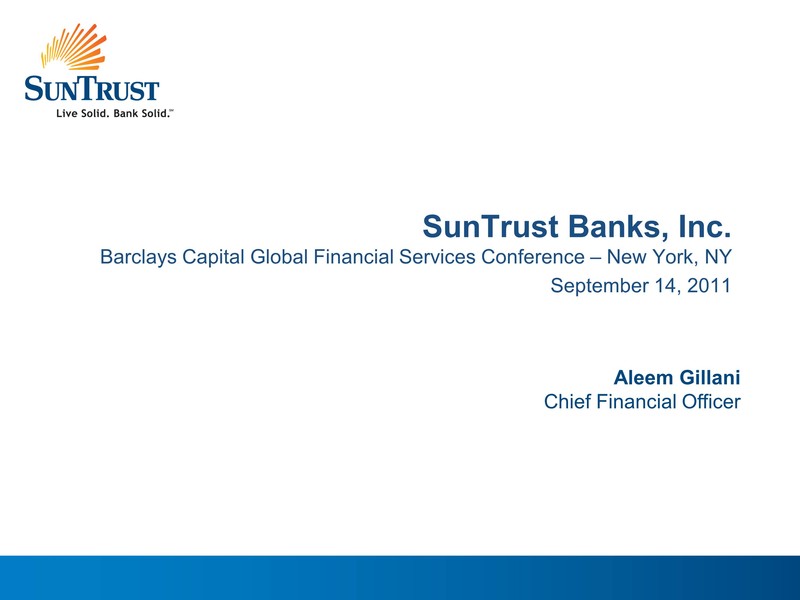
SunTrust Banks, Inc.
Barclays Capital Global Financial Services Conference – New York, NY September 14, 2011
Aleem Gillani Chief Financial Officer
Barclays Capital Global Financial Services Conference – New York, NY September 14, 2011
Aleem Gillani Chief Financial Officer
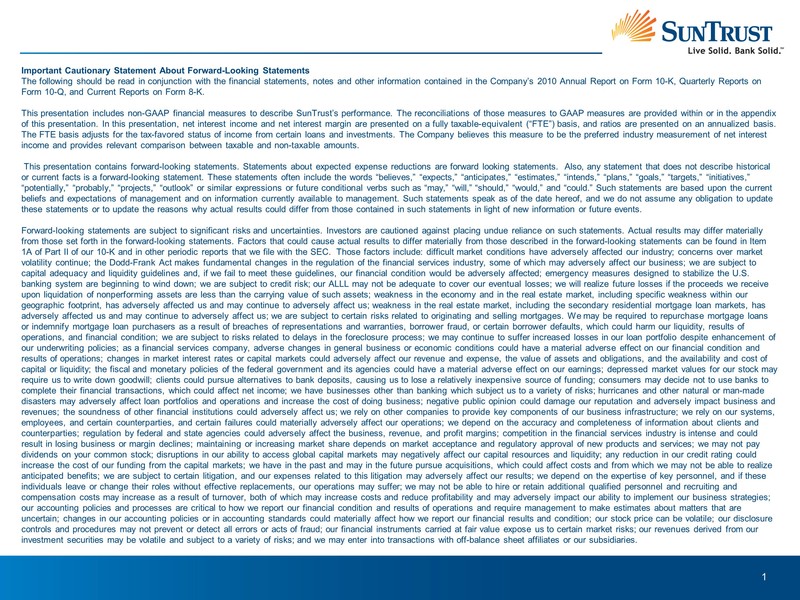
Important Cautionary Statement About Forward-Looking Statements
The following should be read in conjunction with the financial statements, notes and other information contained in the Company’s 2010 Annual Report on Form 10-K, Quarterly Reports on Form 10-Q, and Current Reports on Form 8-K.
This presentation includes non-GAAP financial measures to describe SunTrust’s performance. The reconciliations of those measures to GAAP measures are provided within or in the appendix of this presentation. In this presentation, net interest income and net interest margin are presented on a fully taxable-equivalent (“FTE”) basis, and ratios are presented on an annualized basis. The FTE basis adjusts for the tax-favored status of income from certain loans and investments. The Company believes this measure to be the preferred industry measurement of net interest income and provides relevant comparison between taxable and non-taxable amounts.
This presentation contains forward-looking statements. Statements about expected expense reductions are forward looking statements. Also, any statement that does not describe historical or current facts is a forward-looking statement. These statements often include the words “believes,” “expects,” “anticipates,” “estimates,” “intends,” “plans,” “goals,” “targets,” “initiatives,” “potentially,” “probably,” “projects,” “outlook” or similar expressions or future conditional verbs such as “may,” “will,” “should,” “would,” and “could.” Such statements are based upon the current beliefs and expectations of management and on information currently available to management. Such statements speak as of the date hereof, and we do not assume any obligation to update these statements or to update the reasons why actual results could differ from those contained in such statements in light of new information or future events.
Forward-looking statements are subject to significant risks and uncertainties. Investors are cautioned against placing undue reliance on such statements. Actual results may differ materially from those set forth in the forward-looking statements. Factors that could cause actual results to differ materially from those described in the forward-looking statements can be found in Item 1A of Part II of our 10-K and in other periodic reports that we file with the SEC. Those factors include: difficult market conditions have adversely affected our industry; concerns over market volatility continue; the Dodd-Frank Act makes fundamental changes in the regulation of the financial services industry, some of which may adversely affect our business; we are subject to capital adequacy and liquidity guidelines and, if we fail to meet these guidelines, our financial condition would be adversely affected; emergency measures designed to stabilize the U.S. banking system are beginning to wind down; we are subject to credit risk; our ALLL may not be adequate to cover our eventual losses; we will realize future losses if the proceeds we receive upon liquidation of nonperforming assets are less than the carrying value of such assets; weakness in the economy and in the real estate market, including specific weakness within our geographic footprint, has adversely affected us and may continue to adversely affect us; weakness in the real estate market, including the secondary residential mortgage loan markets, has adversely affected us and may continue to adversely affect us; we are subject to certain risks related to originating and selling mortgages. We may be required to repurchase mortgage loans or indemnify mortgage loan purchasers as a result of breaches of representations and warranties, borrower fraud, or certain borrower defaults, which could harm our liquidity, results of operations, and financial condition; we are subject to risks related to delays in the foreclosure process; we may continue to suffer increased losses in our loan portfolio despite enhancement of our underwriting policies; as a financial services company, adverse changes in general business or economic conditions could have a material adverse effect on our financial condition and results of operations; changes in market interest rates or capital markets could adversely affect our revenue and expense, the value of assets and obligations, and the availability and cost of capital or liquidity; the fiscal and monetary policies of the federal government and its agencies could have a material adverse effect on our earnings; depressed market values for our stock may require us to write down goodwill; clients could pursue alternatives to bank deposits, causing us to lose a relatively inexpensive source of funding; consumers may decide not to use banks to complete their financial transactions, which could affect net income; we have businesses other than banking which subject us to a variety of risks; hurricanes and other natural or man-made disasters may adversely affect loan portfolios and operations and increase the cost of doing business; negative public opinion could damage our reputation and adversely impact business and revenues; the soundness of other financial institutions could adversely affect us; we rely on other companies to provide key components of our business infrastructure; we rely on our systems, employees, and certain counterparties, and certain failures could materially adversely affect our operations; we depend on the accuracy and completeness of information about clients and counterparties; regulation by federal and state agencies could adversely affect the business, revenue, and profit margins; competition in the financial services industry is intense and could result in losing business or margin declines; maintaining or increasing market share depends on market acceptance and regulatory approval of new products and services; we may not pay dividends on your common stock; disruptions in our ability to access global capital markets may negatively affect our capital resources and liquidity; any reduction in our credit rating could increase the cost of our funding from the capital markets; we have in the past and may in the future pursue acquisitions, which could affect costs and from which we may not be able to realize anticipated benefits; we are subject to certain litigation, and our expenses related to this litigation may adversely affect our results; we depend on the expertise of key personnel, and if these individuals leave or change their roles without effective replacements, our operations may suffer; we may not be able to hire or retain additional qualified personnel and recruiting and compensation costs may increase as a result of turnover, both of which may increase costs and reduce profitability and may adversely impact our ability to implement our business strategies; our accounting policies and processes are critical to how we report our financial condition and results of operations and require management to make estimates about matters that are uncertain; changes in our accounting policies or in accounting standards could materially affect how we report our financial results and condition; our stock price can be volatile; our disclosure controls and procedures may not prevent or detect all errors or acts of fraud; our financial instruments carried at fair value expose us to certain market risks; our revenues derived from our investment securities may be volatile and subject to a variety of risks; and we may enter into transactions with off-balance sheet affiliates or our subsidiaries.
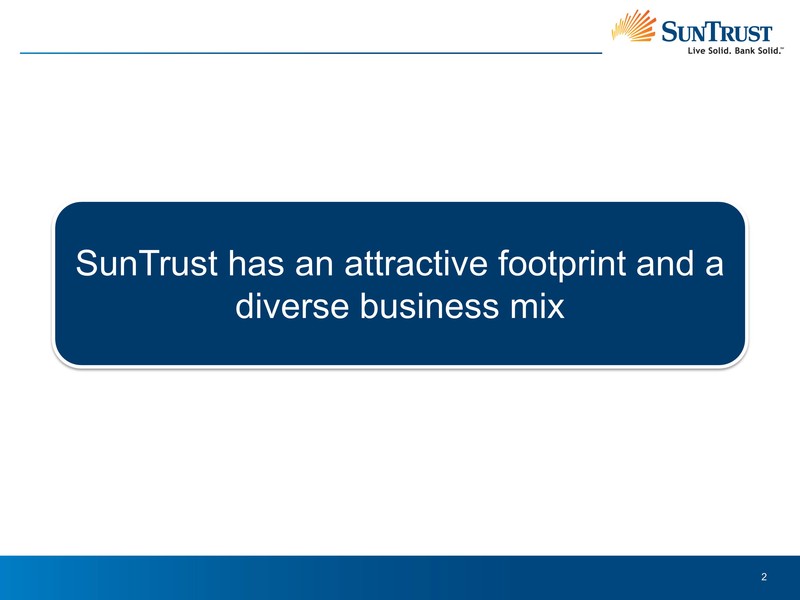
SunTrust has an attractive footprint and a diverse business mix
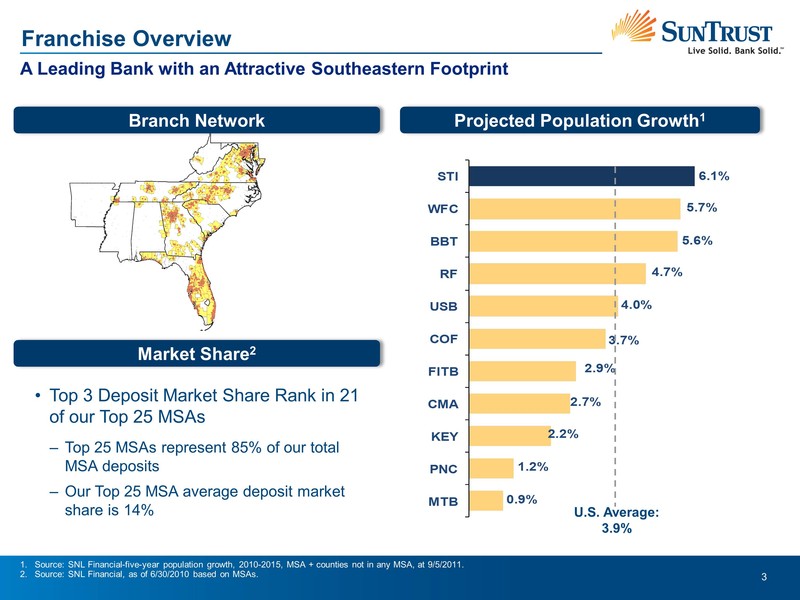
A Leading Bank with an Attractive Southeastern Footprint
Franchise Overview
Branch Network
Projected Population Growth1
Market Share2
Top 3 Deposit Market Share Rank in 21 of our Top 25 MSAs Top 25 MSAs represent 85% of our total MSA deposits Our Top 25 MSA average deposit market share is 14%
Source: SNL Financial-five-year population growth, 2010-2015, MSA + counties not in any MSA, at 9/5/2011. Source: SNL Financial, as of 6/30/2010 based on MSAs.
Franchise Overview
Branch Network
Projected Population Growth1
Market Share2
Top 3 Deposit Market Share Rank in 21 of our Top 25 MSAs Top 25 MSAs represent 85% of our total MSA deposits Our Top 25 MSA average deposit market share is 14%
Source: SNL Financial-five-year population growth, 2010-2015, MSA + counties not in any MSA, at 9/5/2011. Source: SNL Financial, as of 6/30/2010 based on MSAs.
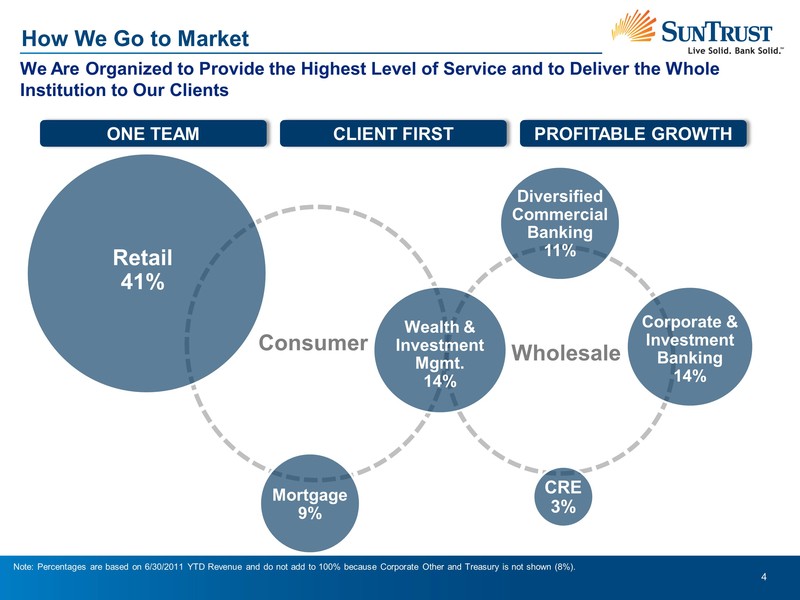
How We Go to Market
We Are Organized to Provide the Highest Level of Service and to Deliver the Whole Institution to Our Clients
ONE TEAM
CLIENT FIRST
PROFITABLE GROWTH
Note: Percentages are based on 6/30/2011 YTD Revenue and do not add to 100% because Corporate Other and Treasury is not shown (8%).
We Are Organized to Provide the Highest Level of Service and to Deliver the Whole Institution to Our Clients
ONE TEAM
CLIENT FIRST
PROFITABLE GROWTH
Note: Percentages are based on 6/30/2011 YTD Revenue and do not add to 100% because Corporate Other and Treasury is not shown (8%).
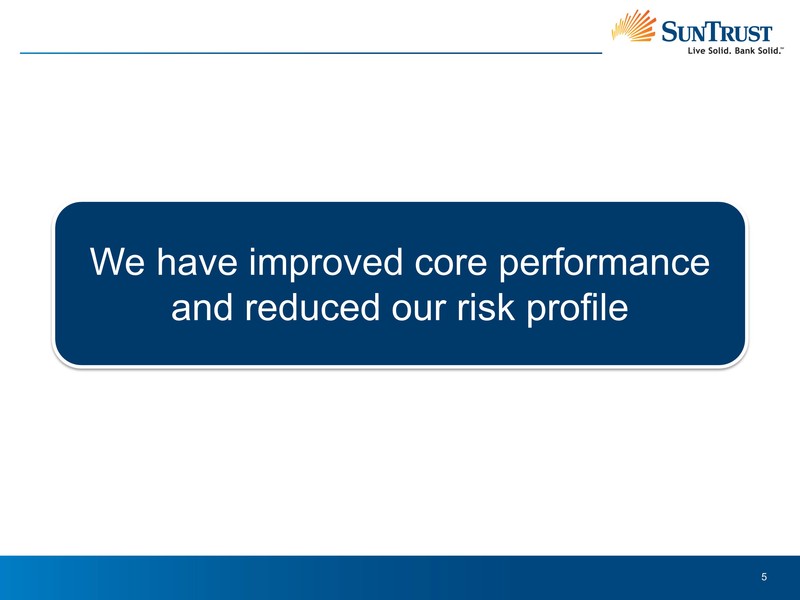
We have improved core performance and reduced our risk profile
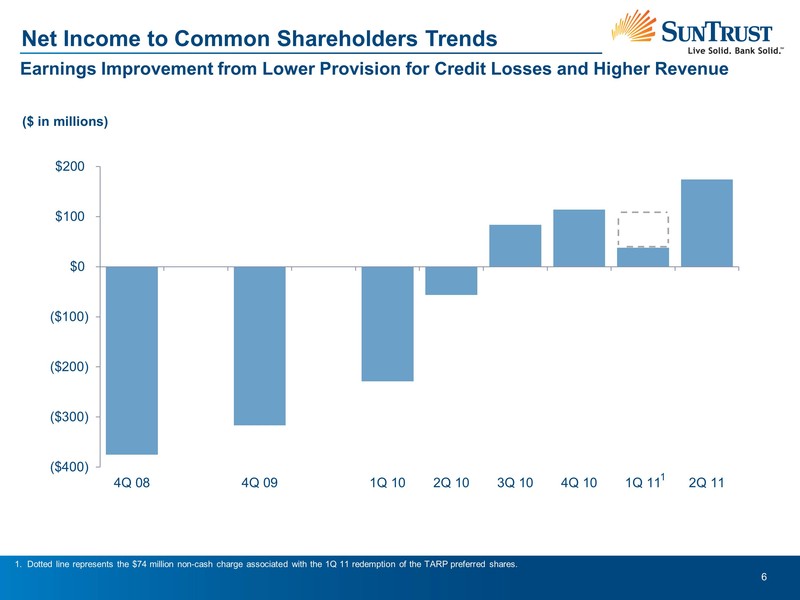
Earnings Improvement from Lower Provision for Credit Losses and Higher Revenue
Net Income to Common Shareholders Trends
($ in millions)
1. Dotted line represents the $74 million non-cash charge associated with the 1Q 11 redemption of the TARP preferred shares.
1
Net Income to Common Shareholders Trends
($ in millions)
1. Dotted line represents the $74 million non-cash charge associated with the 1Q 11 redemption of the TARP preferred shares.
1
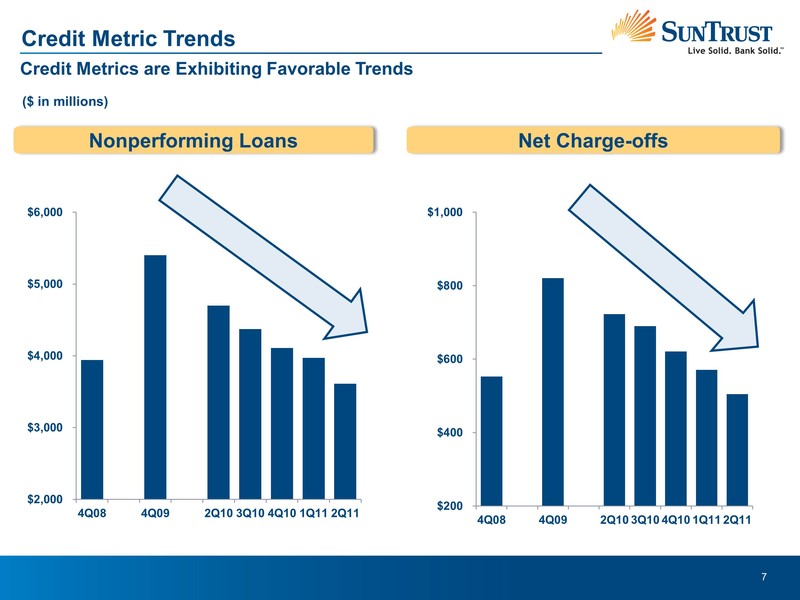
Credit Metrics are Exhibiting Favorable Trends
Credit Metric Trends
Nonperforming Loans
Net Charge-offs
($ in millions)
Credit Metric Trends
Nonperforming Loans
Net Charge-offs
($ in millions)
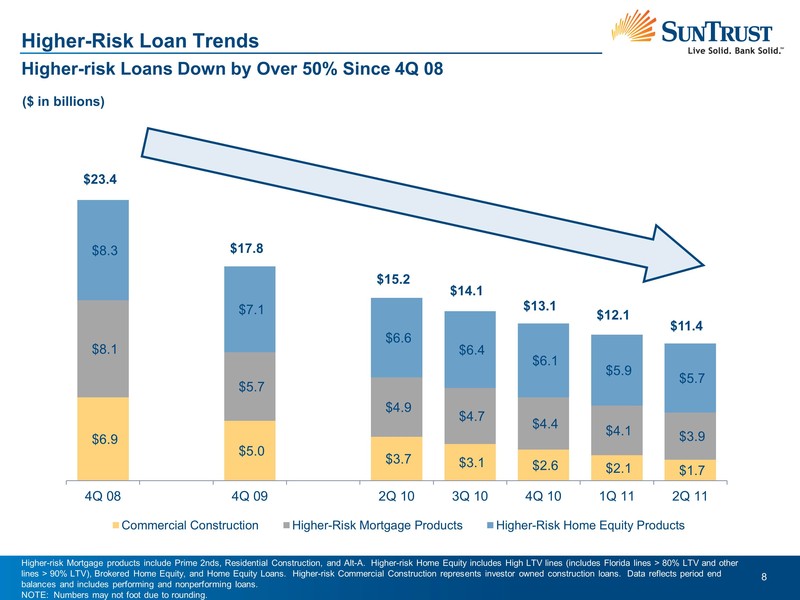
Higher-Risk Loan Trends
Higher-risk Loans Down by Over 50% Since 4Q 08
($ in billions)
$23.4
$13.1
$12.1
$11.4
$15.2
$14.1
Higher-risk Mortgage products include Prime 2nds, Residential Construction, and Alt-A. Higher-risk Home Equity includes High LTV lines (includes Florida lines > 80% LTV and other lines > 90% LTV), Brokered Home Equity, and Home Equity Loans. Higher-risk Commercial Construction represents investor owned construction loans. Data reflects period end balances and includes performing and nonperforming loans. NOTE: Numbers may not foot due to rounding.
$17.8
Higher-risk Loans Down by Over 50% Since 4Q 08
($ in billions)
$23.4
$13.1
$12.1
$11.4
$15.2
$14.1
Higher-risk Mortgage products include Prime 2nds, Residential Construction, and Alt-A. Higher-risk Home Equity includes High LTV lines (includes Florida lines > 80% LTV and other lines > 90% LTV), Brokered Home Equity, and Home Equity Loans. Higher-risk Commercial Construction represents investor owned construction loans. Data reflects period end balances and includes performing and nonperforming loans. NOTE: Numbers may not foot due to rounding.
$17.8
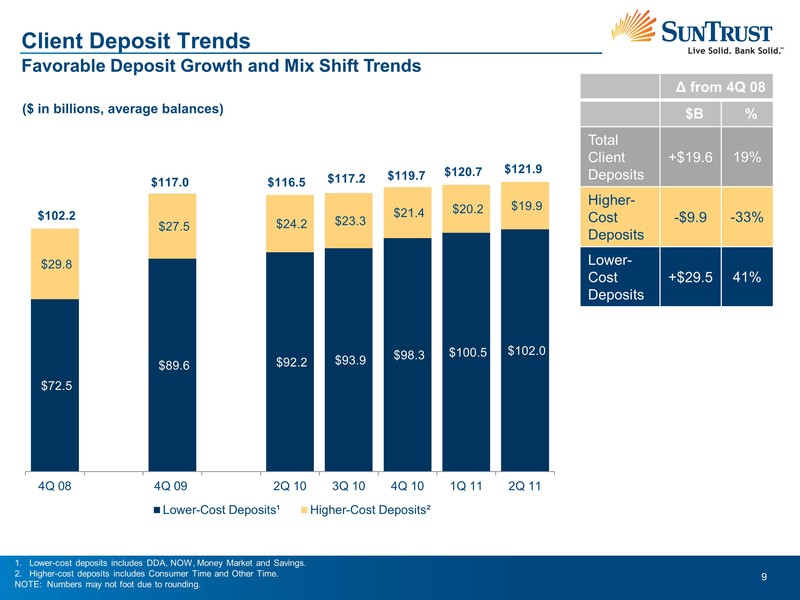
Client Deposit Trends
($ in billions, average balances)
Favorable Deposit Growth and Mix Shift Trends
Lower-cost deposits includes DDA, NOW, Money Market and Savings. Higher-cost deposits includes Consumer Time and Other Time. NOTE: Numbers may not foot due to rounding.
$102.2
$116.5
$117.0
$117.2
$119.7
$120.7
$121.9
($ in billions, average balances)
Favorable Deposit Growth and Mix Shift Trends
Lower-cost deposits includes DDA, NOW, Money Market and Savings. Higher-cost deposits includes Consumer Time and Other Time. NOTE: Numbers may not foot due to rounding.
$102.2
$116.5
$117.0
$117.2
$119.7
$120.7
$121.9
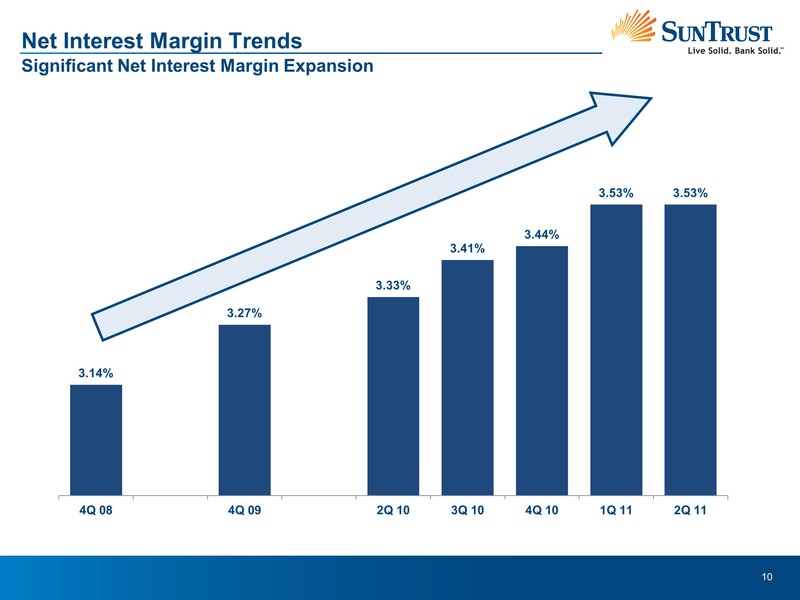
Net Interest Margin Trends
Significant Net Interest Margin Expansion
Significant Net Interest Margin Expansion
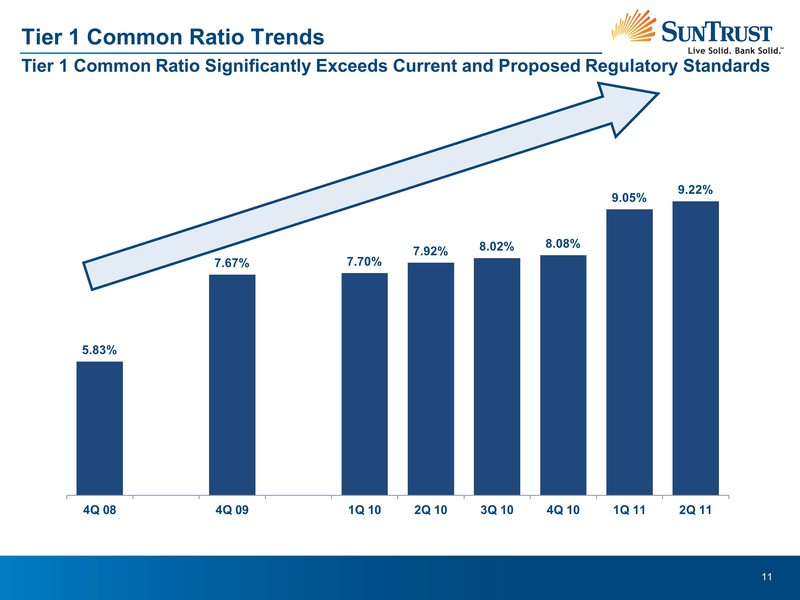
Tier 1 Common Ratio Trends
Tier 1 Common Ratio Significantly Exceeds Current and Proposed Regulatory Standards
Tier 1 Common Ratio Significantly Exceeds Current and Proposed Regulatory Standards
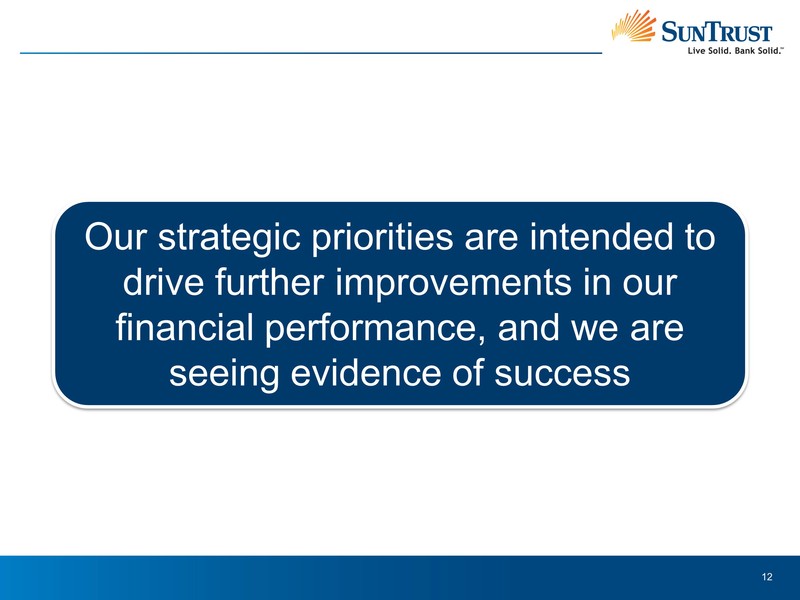
Our strategic priorities are intended to drive further improvements in our financial performance, and we are seeing evidence of success
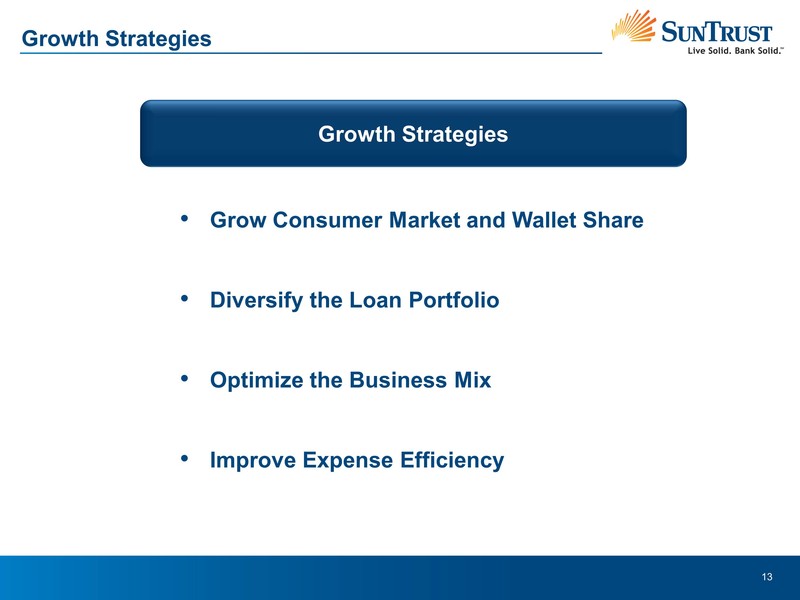
Growth Strategies
Grow Consumer Market and Wallet Share Diversify the Loan Portfolio Optimize the Business Mix Improve Expense Efficiency
Growth Strategies
Grow Consumer Market and Wallet Share Diversify the Loan Portfolio Optimize the Business Mix Improve Expense Efficiency
Growth Strategies
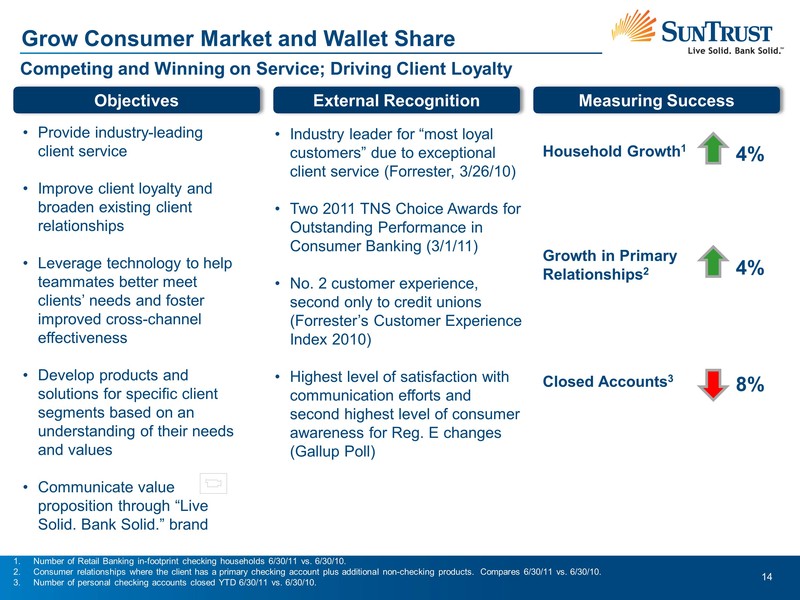
Grow Consumer Market and Wallet Share
Competing and Winning on Service; Driving Client Loyalty
Number of Retail Banking in-footprint checking households 6/30/11 vs. 6/30/10. Consumer relationships where the client has a primary checking account plus additional non-checking products. Compares 6/30/11 vs. 6/30/10. Number of personal checking accounts closed YTD 6/30/11 vs. 6/30/10.
Industry leader for “most loyal customers” due to exceptional client service (Forrester, 3/26/10) Two 2011 TNS Choice Awards for Outstanding Performance in Consumer Banking (3/1/11) No. 2 customer experience, second only to credit unions (Forrester’s Customer Experience Index 2010) Highest level of satisfaction with communication efforts and second highest level of consumer awareness for Reg. E changes (Gallup Poll)
Growth in Primary Relationships2
External Recognition
Closed Accounts3
4%
Measuring Success
Household Growth1
8%
4%
Objectives
Provide industry-leading client service Improve client loyalty and broaden existing client relationships Leverage technology to help teammates better meet clients’ needs and foster improved cross-channel effectiveness Develop products and solutions for specific client segments based on an understanding of their needs and values Communicate value proposition through “Live Solid. Bank Solid.” brand
Competing and Winning on Service; Driving Client Loyalty
Number of Retail Banking in-footprint checking households 6/30/11 vs. 6/30/10. Consumer relationships where the client has a primary checking account plus additional non-checking products. Compares 6/30/11 vs. 6/30/10. Number of personal checking accounts closed YTD 6/30/11 vs. 6/30/10.
Industry leader for “most loyal customers” due to exceptional client service (Forrester, 3/26/10) Two 2011 TNS Choice Awards for Outstanding Performance in Consumer Banking (3/1/11) No. 2 customer experience, second only to credit unions (Forrester’s Customer Experience Index 2010) Highest level of satisfaction with communication efforts and second highest level of consumer awareness for Reg. E changes (Gallup Poll)
Growth in Primary Relationships2
External Recognition
Closed Accounts3
4%
Measuring Success
Household Growth1
8%
4%
Objectives
Provide industry-leading client service Improve client loyalty and broaden existing client relationships Leverage technology to help teammates better meet clients’ needs and foster improved cross-channel effectiveness Develop products and solutions for specific client segments based on an understanding of their needs and values Communicate value proposition through “Live Solid. Bank Solid.” brand

Resi Mortgage--Nonguaranteed
Diversify the Loan Portfolio
Changing the Portfolio Composition to Improve Diversification
Loan Portfolio Composition – 6/30/11
Changes from 12/31/08
12%
Construction
71%
Portfolios Managed Down
Portfolios Targeted for Growth
Consumer
42%
Guaranteed
211%
Total Loans at 6/30/2011: $115B
Total Loans at 12/31/2008: $127B
SBA Lending (C&I)
Asset-Based Lending (C&I)
64%
121%
Consumer includes direct consumer loans (other than student guaranteed), consumer indirect loans, and consumer credit cards. Guaranteed includes guaranteed student loans and guaranteed residential mortgages. Construction includes both commercial and residential construction. NOTE: Numbers may not foot due to rounding.
Diversify the Loan Portfolio
Changing the Portfolio Composition to Improve Diversification
Loan Portfolio Composition – 6/30/11
Changes from 12/31/08
12%
Construction
71%
Portfolios Managed Down
Portfolios Targeted for Growth
Consumer
42%
Guaranteed
211%
Total Loans at 6/30/2011: $115B
Total Loans at 12/31/2008: $127B
SBA Lending (C&I)
Asset-Based Lending (C&I)
64%
121%
Consumer includes direct consumer loans (other than student guaranteed), consumer indirect loans, and consumer credit cards. Guaranteed includes guaranteed student loans and guaranteed residential mortgages. Construction includes both commercial and residential construction. NOTE: Numbers may not foot due to rounding.
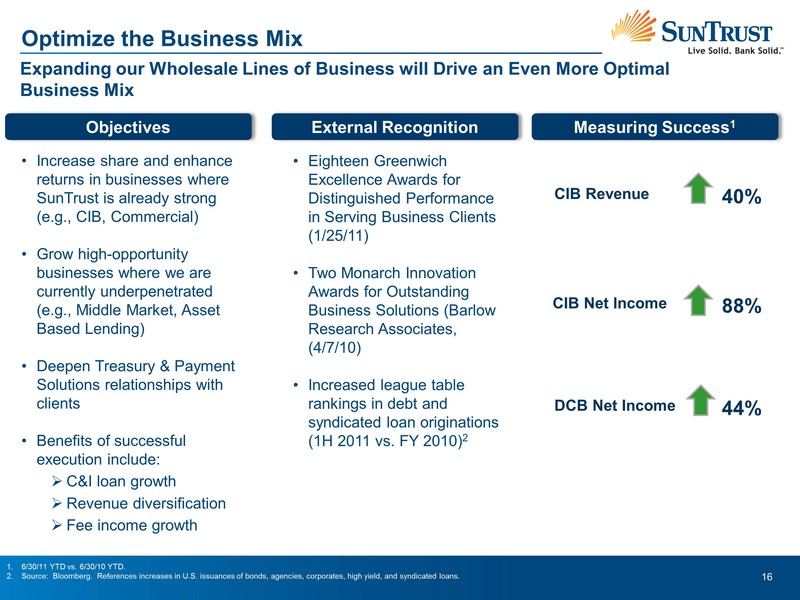
Optimize the Business Mix
Expanding our Wholesale Lines of Business will Drive an Even More Optimal Business Mix
Eighteen Greenwich Excellence Awards for Distinguished Performance in Serving Business Clients (1/25/11) Two Monarch Innovation Awards for Outstanding Business Solutions (Barlow Research Associates, (4/7/10) Increased league table rankings in debt and syndicated loan originations (1H 2011 vs. FY 2010)2
External Recognition
Measuring Success1
Objectives
Increase share and enhance returns in businesses where SunTrust is already strong (e.g., CIB, Commercial) Grow high-opportunity businesses where we are currently underpenetrated (e.g., Middle Market, Asset Based Lending) Deepen Treasury & Payment Solutions relationships with clients Benefits of successful execution include: C&I loan growth Revenue diversification Fee income growth
DCB Net Income
CIB Net Income
40%
CIB Revenue
88%
6/30/11 YTD vs. 6/30/10 YTD. Source: Bloomberg. References increases in U.S. issuances of bonds, agencies, corporates, high yield, and syndicated loans.
44%
Expanding our Wholesale Lines of Business will Drive an Even More Optimal Business Mix
Eighteen Greenwich Excellence Awards for Distinguished Performance in Serving Business Clients (1/25/11) Two Monarch Innovation Awards for Outstanding Business Solutions (Barlow Research Associates, (4/7/10) Increased league table rankings in debt and syndicated loan originations (1H 2011 vs. FY 2010)2
External Recognition
Measuring Success1
Objectives
Increase share and enhance returns in businesses where SunTrust is already strong (e.g., CIB, Commercial) Grow high-opportunity businesses where we are currently underpenetrated (e.g., Middle Market, Asset Based Lending) Deepen Treasury & Payment Solutions relationships with clients Benefits of successful execution include: C&I loan growth Revenue diversification Fee income growth
DCB Net Income
CIB Net Income
40%
CIB Revenue
88%
6/30/11 YTD vs. 6/30/10 YTD. Source: Bloomberg. References increases in U.S. issuances of bonds, agencies, corporates, high yield, and syndicated loans.
44%
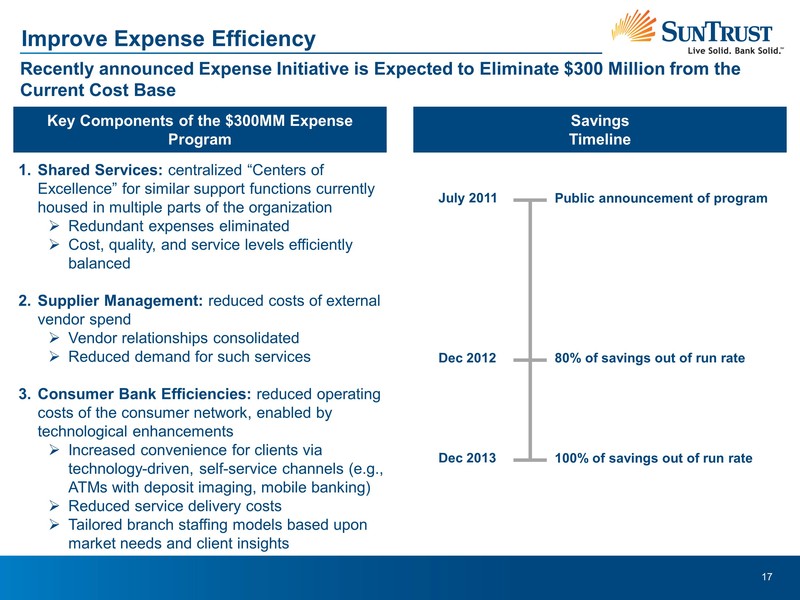
Shared Services: centralized “Centers of Excellence” for similar support functions currently housed in multiple parts of the organization
Redundant expenses eliminated
Cost, quality, and service levels efficiently balanced
Supplier Management: reduced costs of external vendor spend
Vendor relationships consolidated
Reduced demand for such services
Consumer Bank Efficiencies: reduced operating costs of the consumer network, enabled by technological enhancements
Increased convenience for clients via technology-driven, self-service channels (e.g., ATMs with deposit imaging, mobile banking)
Reduced service delivery costs
Tailored branch staffing models based upon market needs and client insights
Improve Expense Efficiency
Recently announced Expense Initiative is Expected to Eliminate $300 Million from the Current Cost Base
Key Components of the $300MM Expense Program
Savings Timeline
Improve Expense Efficiency
Recently announced Expense Initiative is Expected to Eliminate $300 Million from the Current Cost Base
Key Components of the $300MM Expense Program
Savings Timeline
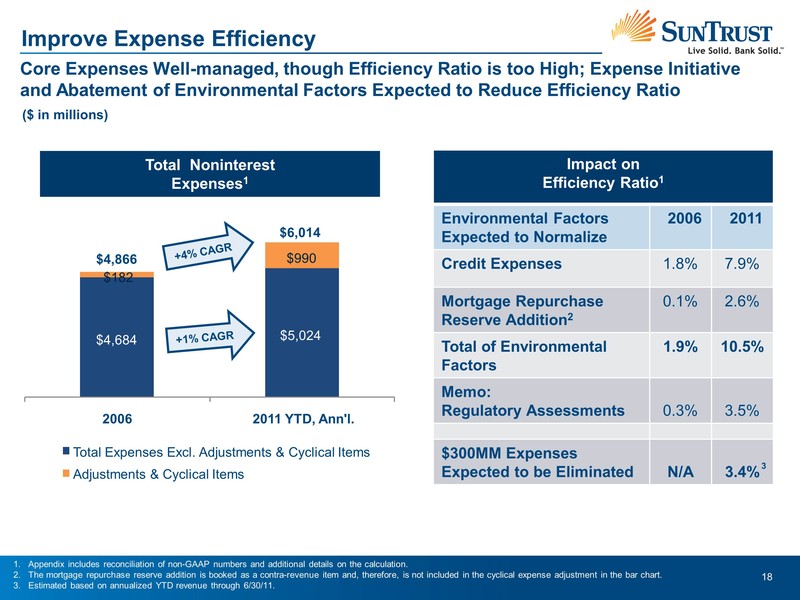
Total Noninterest
Expenses1
Improve Expense Efficiency
Core Expenses Well-managed, though Efficiency Ratio is too High; Expense Initiative and Abatement of Environmental Factors Expected to Reduce Efficiency Ratio
Appendix includes reconciliation of non-GAAP numbers and additional details on the calculation. The mortgage repurchase reserve addition is booked as a contra-revenue item and, therefore, is not included in the cyclical expense adjustment in the bar chart. Estimated based on annualized YTD revenue through 6/30/11.
($ in millions)
3
Improve Expense Efficiency
Core Expenses Well-managed, though Efficiency Ratio is too High; Expense Initiative and Abatement of Environmental Factors Expected to Reduce Efficiency Ratio
Appendix includes reconciliation of non-GAAP numbers and additional details on the calculation. The mortgage repurchase reserve addition is booked as a contra-revenue item and, therefore, is not included in the cyclical expense adjustment in the bar chart. Estimated based on annualized YTD revenue through 6/30/11.
($ in millions)
3
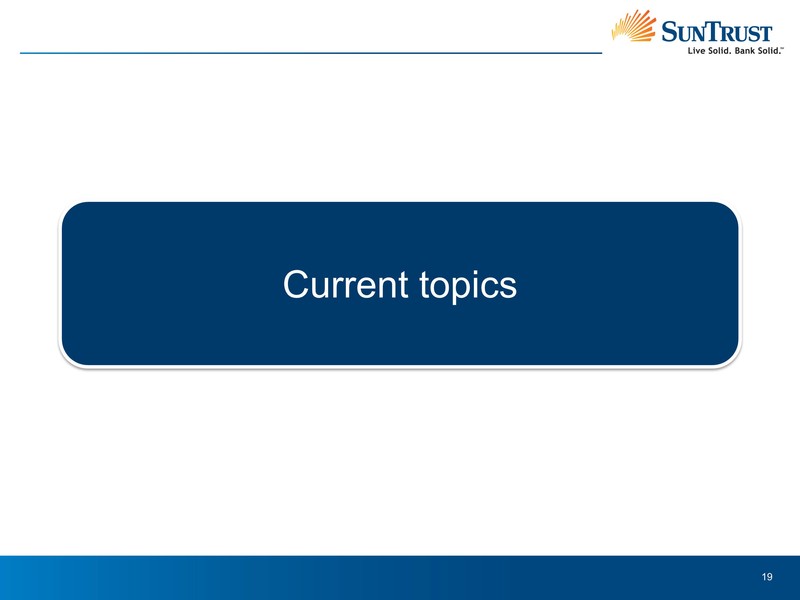
Current topics
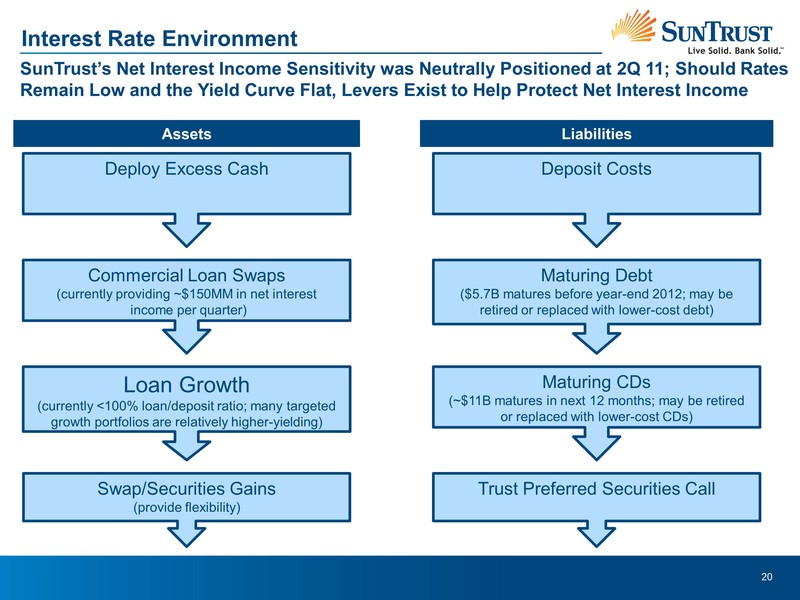
2013
Interest Rate Environment
SunTrust’s Net Interest Income Sensitivity was Neutrally Positioned at 2Q 11; Should Rates Remain Low and the Yield Curve Flat, Levers Exist to Help Protect Net Interest Income
Assets
Liabilities
Commercial Loan Swaps (currently providing ~$150MM in net interest income per quarter)
Trust Preferred Securities Call
Maturing Debt ($5.7B matures before year-end 2012; may be retired or replaced with lower-cost debt)
Maturing CDs (~$11B matures in next 12 months; may be retired or replaced with lower-cost CDs)
Deposit Costs
Loan Growth (currently <100% loan/deposit ratio; many targeted growth portfolios are relatively higher-yielding)
Swap/Securities Gains (provide flexibility)
Deploy Excess Cash
Interest Rate Environment
SunTrust’s Net Interest Income Sensitivity was Neutrally Positioned at 2Q 11; Should Rates Remain Low and the Yield Curve Flat, Levers Exist to Help Protect Net Interest Income
Assets
Liabilities
Commercial Loan Swaps (currently providing ~$150MM in net interest income per quarter)
Trust Preferred Securities Call
Maturing Debt ($5.7B matures before year-end 2012; may be retired or replaced with lower-cost debt)
Maturing CDs (~$11B matures in next 12 months; may be retired or replaced with lower-cost CDs)
Deposit Costs
Loan Growth (currently <100% loan/deposit ratio; many targeted growth portfolios are relatively higher-yielding)
Swap/Securities Gains (provide flexibility)
Deploy Excess Cash
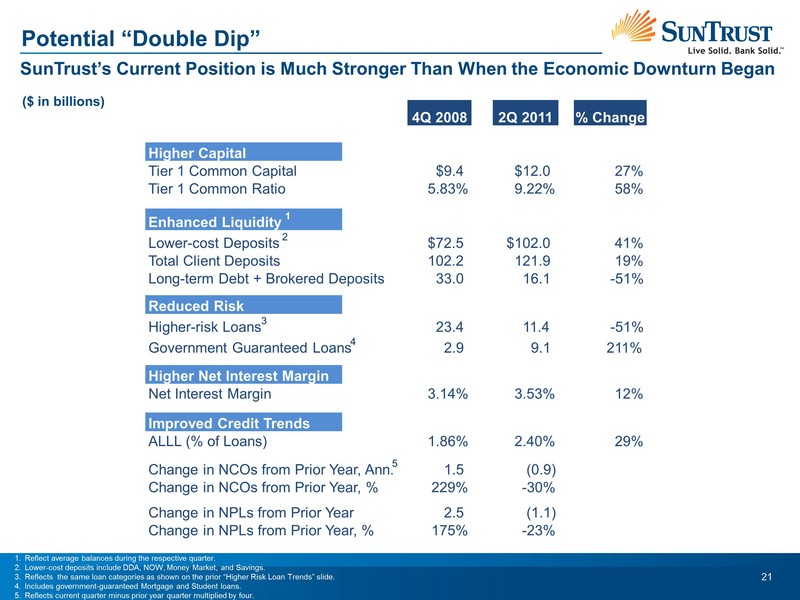
Potential “Double Dip”
SunTrust’s Current Position is Much Stronger Than When the Economic Downturn Began
($ in billions)
Reflect average balances during the respective quarter. Lower-cost deposits include DDA, NOW, Money Market, and Savings. Reflects the same loan categories as shown on the prior “Higher Risk Loan Trends” slide. Includes government-guaranteed Mortgage and Student loans. Reflects current quarter minus prior year quarter multiplied by four.
SunTrust’s Current Position is Much Stronger Than When the Economic Downturn Began
($ in billions)
Reflect average balances during the respective quarter. Lower-cost deposits include DDA, NOW, Money Market, and Savings. Reflects the same loan categories as shown on the prior “Higher Risk Loan Trends” slide. Includes government-guaranteed Mortgage and Student loans. Reflects current quarter minus prior year quarter multiplied by four.
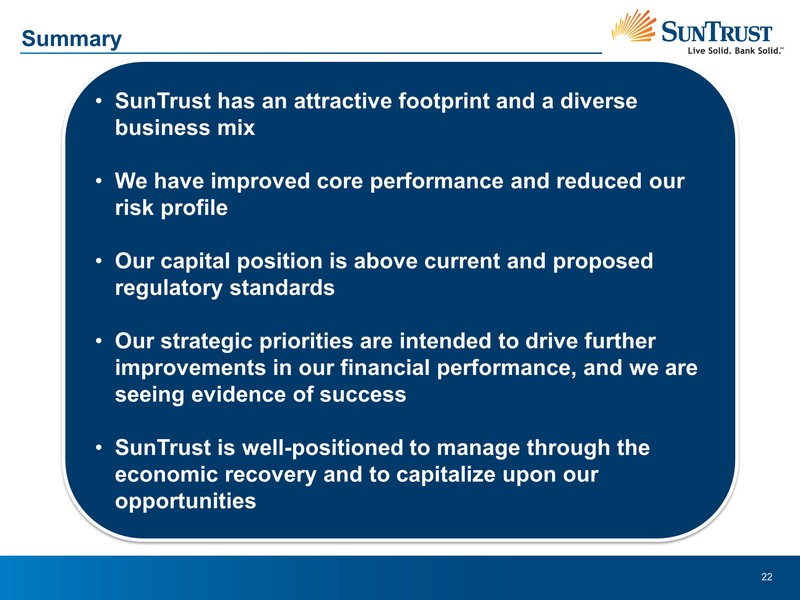
Summary
SunTrust has an attractive footprint and a diverse business mix We have improved core performance and reduced our risk profile Our capital position is above current and proposed regulatory standards Our strategic priorities are intended to drive further improvements in our financial performance, and we are seeing evidence of success SunTrust is well-positioned to manage through the economic recovery and to capitalize upon our opportunities
SunTrust has an attractive footprint and a diverse business mix We have improved core performance and reduced our risk profile Our capital position is above current and proposed regulatory standards Our strategic priorities are intended to drive further improvements in our financial performance, and we are seeing evidence of success SunTrust is well-positioned to manage through the economic recovery and to capitalize upon our opportunities
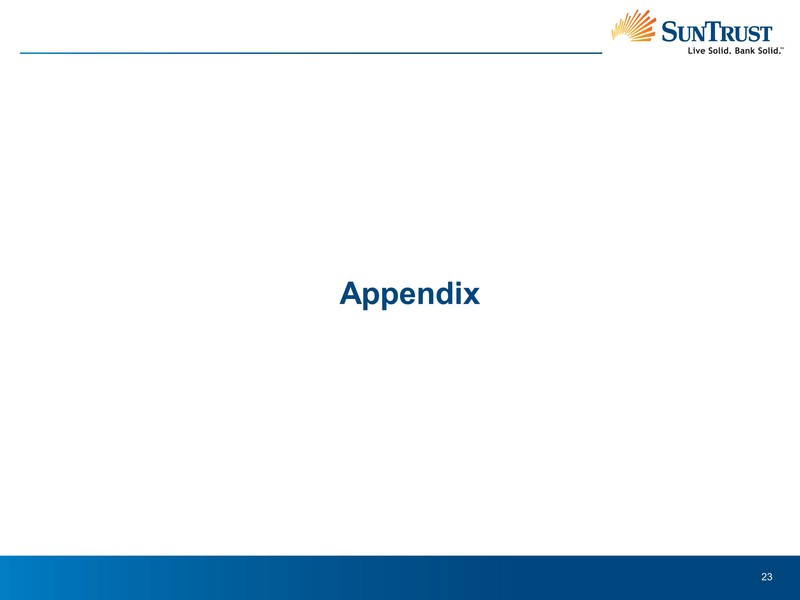
Appendix
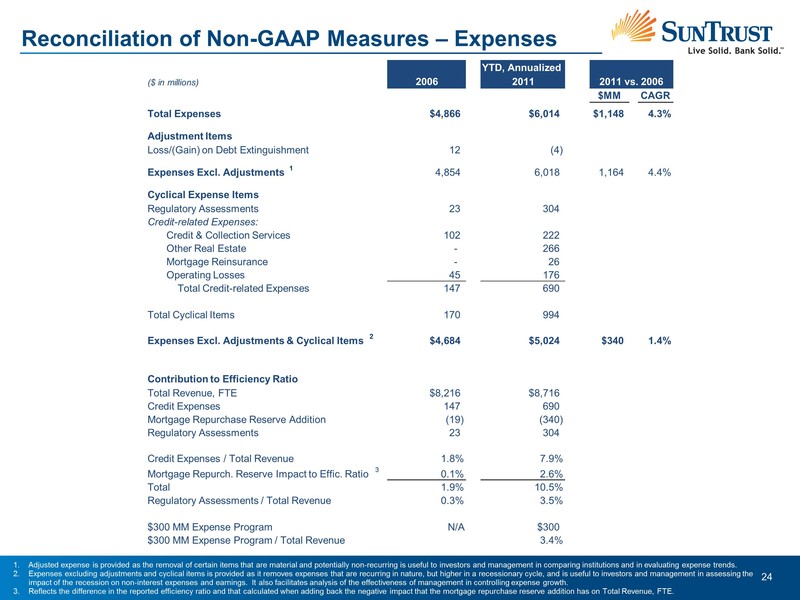
Reconciliation of Non-GAAP Measures – Expenses
Adjusted expense is provided as the removal of certain items that are material and potentially non-recurring is useful to investors and management in comparing institutions and in evaluating expense trends. Expenses excluding adjustments and cyclical items is provided as it removes expenses that are recurring in nature, but higher in a recessionary cycle, and is useful to investors and management in assessing the impact of the recession on non-interest expenses and earnings. It also facilitates analysis of the effectiveness of management in controlling expense growth. Reflects the difference in the reported efficiency ratio and that calculated when adding back the negative impact that the mortgage repurchase reserve addition has on Total Revenue, FTE.
Adjusted expense is provided as the removal of certain items that are material and potentially non-recurring is useful to investors and management in comparing institutions and in evaluating expense trends. Expenses excluding adjustments and cyclical items is provided as it removes expenses that are recurring in nature, but higher in a recessionary cycle, and is useful to investors and management in assessing the impact of the recession on non-interest expenses and earnings. It also facilitates analysis of the effectiveness of management in controlling expense growth. Reflects the difference in the reported efficiency ratio and that calculated when adding back the negative impact that the mortgage repurchase reserve addition has on Total Revenue, FTE.
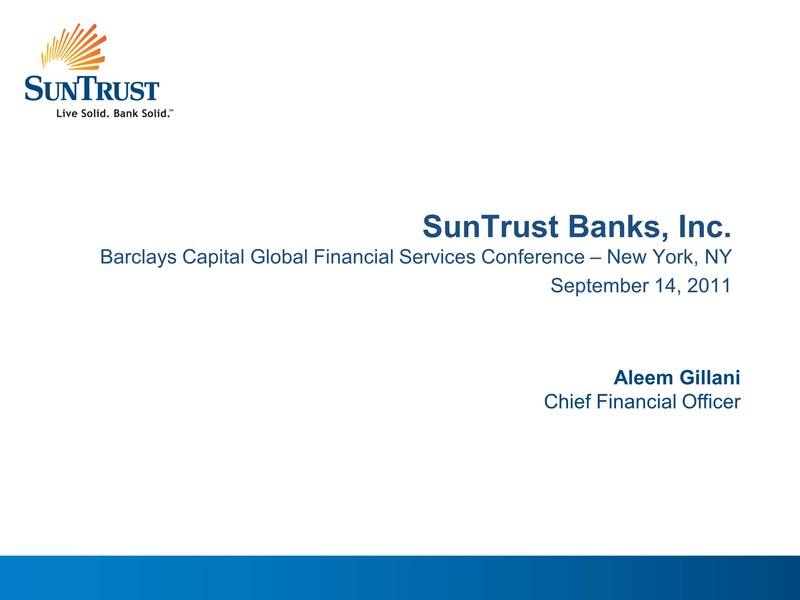
SunTrust Banks, Inc.
Barclays Capital Global Financial Services Conference – New York, NY September 14, 2011
Aleem Gillani Chief Financial Officer
Barclays Capital Global Financial Services Conference – New York, NY September 14, 2011
Aleem Gillani Chief Financial Officer
